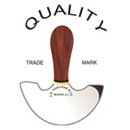
19 Apr What Pros Never Tell You About Their Cutting Edge – 4 Secrets
You’ll rarely hear a seasoned leatherworker talk about their favorite knife. They’ll just pick it up, make the cut, and move on. No flash, no fuss. But that edge they’re using? It’s no ordinary blade. It’s been chosen, tuned, and trusted through hundreds of projects. There’s a reason it never misses.
Tradition Over Trend
Pros don’t reach for what’s new. They reach for what’s proven. Osborne cutting tools have earned their keep by doing one thing really well—cutting clean, smooth, and without compromise. They don’t need neon handles or gimmicks. Just solid steel, balanced weight, and a shape that’s been refined by actual makers over generations.
Sharpening is Part of the Process
A sharp blade isn’t something you wait for. It’s something you keep. Professionals don’t wait until the knife struggles. They sharpen often, sometimes out of habit, sometimes just because the edge doesn’t quite sing like it should.
It’s less about repair, more about rhythm. Maintenance becomes muscle memory. And the result? Fewer mistakes. Cleaner work. No wasted effort.
Fewer Tools, More Mastery
Open a pro’s tool roll, and you won’t find a dozen cutting gadgets. Just a few tools—worn in, well-loved, and deadly precise.
- A round knife for graceful curves and confident control
- A straight blade for clean, no-nonsense lines
- A skiver with just the right bite for thinning edges
They don’t chase variety. They chase consistency. And they know how each tool behaves like an old friend.
The Blade Doesn’t Force—It Listens
This is the difference no one talks about. The best cutting tools don’t demand pressure. They glide. They understand the material. If there’s resistance, the pro doesn’t push—they adjust. A flick of the wrist. A change in angle. A quiet conversation with the leather.
And Osborne tools? They’re made to respond to that kind of subtlety.
You Can See the Difference in the Cut
There’s no chatter on the edge. No fuzz. No hesitation. Just clean, confident lines that fit together like they were drawn there.
Because in the end, the tool may be quiet—but the work it produces? Speaks volumes. And that, right there, is the secret pros never have to say out loud.


